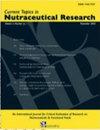原花青素A1抑制棕榈酸处理HepG2细胞的胰岛素抵抗和氧化应激
IF 0.4
4区 医学
Q4 NUTRITION & DIETETICS
Current Topics in Nutraceutical Research
Pub Date : 2022-03-16
DOI:10.37290/ctnr2641-452x.20:561-566
引用次数: 1
摘要
本研究探讨了原花青素A1对棕榈酸处理HepG2细胞胰岛素抵抗和氧化应激的影响。HepG2细胞先用原花青素A1预处理,再用棕榈酸预处理。用细胞活力和过氧化氢酶、超氧化物歧化酶、谷胱甘肽过氧化物酶和活性氧水平来评估氧化应激。与原花青素A1共处理后,棕榈酸显著降低了细胞活力。此外,原花青素A1可恢复棕榈酸诱导的HepG2细胞的胰岛素抵抗和氧化应激。此外,在棕榈酸处理的HepG2细胞中,P38 MAPK和JNK信号通路的失活与原花青素a1调控的抗性和氧化应激密切相关。综上所述,原花青素A1通过调节P38 MAPK和JNK信号通路抑制棕榈酸处理HepG2细胞的胰岛素抵抗和氧化应激。本文章由计算机程序翻译,如有差异,请以英文原文为准。
Procyanidin A1 Inhibits Insulin Resistance and Oxidative Stress in Palmitic Acid Treated HepG2 Cells
The present study has examined the effect of procyanidin A1 on insulin resistance and oxidative stress in palmitic acid treated HepG2 cells. The HepG2 cells were pretreated with procyanidin A1 and then with palmitic acid. The cell viability and the levels of catalase, superoxide dismutase, glutathione peroxidase, and reactive oxygen were used to assess oxidative stress. Treatment with palmitic acid significantly reduced cell viability that was alleviated by cotreatment with procyanidin A1. In addition, procyanidin A1 restored the palmitic acid induced insulin resistance and oxidative stress in the HepG2 cells. Furthermore, inactivation of P38 MAPK and JNK signaling pathways was closely associated with the procyanidin A1-regulated resistance and oxidative stress in palmitic acid treated HepG2 cells. In conclusion, procyanidin A1 inhibits insulin resistance and oxidative stress in palmitic acid treated HepG2 cells by regulating the P38 MAPK and JNK signaling pathways.
求助全文
通过发布文献求助,成功后即可免费获取论文全文。
去求助
来源期刊
CiteScore
1.10
自引率
0.00%
发文量
36
审稿时长
>12 weeks
期刊介绍:
Current Topics in Nutraceutical Research is an international, interdisciplinary broad-based peer reviewed scientific journal for critical evaluation of research on chemistry, biology and therapeutic applications of nutraceuticals and functional foods. The major goal of this journal is to provide peer reviewed unbiased scientific data to the decision makers in the nutraceutical and food industry to help make informed choices about development of new products.
To this end, the journal will publish two types of review articles. First, a review of preclinical research data coming largely from animal, cell culture and other experimental models. Such data will provide basis for future product development and/or human research initiatives. Second, a critical evaluation of current human experimental data to help market and deliver the product for medically proven use. This journal will also serve as a forum for nutritionists, internists, neurologists, psychiatrists, and all those interested in preventive medicine.
The common denominator of all of the topic to be covered by the journal must include nutraceuticals and/functional food. The following is an example of some specific areas that may be of interest to the journal. i) Role of vitamins, minerals, antioxidants and phytonutrients on cardiovascular health, cancer, diabetes, ocular health, mental health, men’s health, women’s health, infant nutrition, ii) Role of herbals on human health, iii) Dietary supplements and sleep, iv) Components of diet that may have beneficial effect on human health, v) regulation of apoptosis and cell viability, vi) Isolation and characterization of bioactive components from functional foods, vii) Nutritional genomics, and viii) Nutritional proteomics.

 求助内容:
求助内容: 应助结果提醒方式:
应助结果提醒方式:


